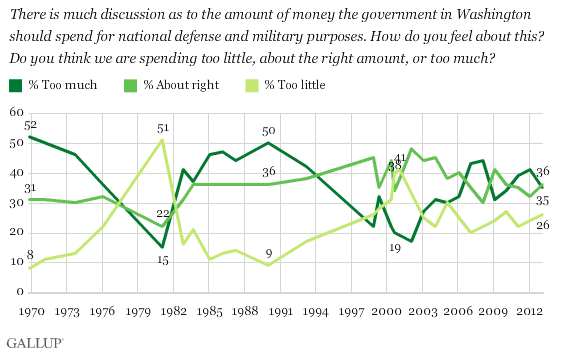PRINCETON, NJ -- As steep cuts in defense spending are scheduled to take place on March 1 unless the federal government acts to prevent them, Americans show no clear consensus on current U.S. defense spending. Thirty-six percent say the U.S. spends the right amount on the military and national defense, 35% say it spends too much, and 26% too little. In the prior two years, the plurality of Americans said too much was spent on defense.

The results are based on Gallup's annual World Affairs poll, conducted Feb. 7-10, updating a trend question Gallup first asked in 1969. Americans' views on defense spending have varied over this time, usually in response to what the United States was doing militarily.
- In the late 1960s and early 1970s as the United States was fighting the Vietnam War, Americans' dominant view was that the U.S. was spending too much on defense.
- In 1981, just after Ronald Reagan took office after making concerns about U.S. military strength in light of the Iranian hostage situation and the Soviet Union's invasion of Afghanistan a major theme of his presidential campaign, Americans shifted to the view that too little was spent on defense.
- As the Reagan administration built up military spending in the 1980s, Americans again came to believe the U.S. was spending too much in this area.
- Near the end of the Clinton administration, as the government made an effort to reduce military spending and George W. Bush's presidential campaign questioned U.S. military strength, an increasing number of Americans said the United States was spending too little on defense.
- In the first several years after the 9/11 terrorist attacks, which included U.S. military operations in Afghanistan and Iraq, Americans most commonly said defense spending was "about right."
- Over the last five years, Americans have alternated in their views between believing the U.S. spends too much and believing it spends the right amount on defense, including this year, when roughly equal percentages of Americans hold each view.
Republicans, Democrats on Opposite Sides of Defense Spending Debate
The scheduled defense spending cuts are part of the 2011 agreement to raise the federal debt limit. The legislation called for deep spending cuts in defense and domestic programs as an undesirable outcome if the bipartisan deficit reduction "supercommittee" could not reach agreement on steps to get the deficit under control. When the supercommittee could not produce a plan, the cuts were scheduled for Jan. 1, 2013, but were postponed earlier this year until March 1 as part of the agreement to avoid raising income taxes for most Americans.
The defense cuts were designed to be the greater incentive for Republicans to agree on deficit reduction, with the domestic cuts the greater incentive for Democrats to agree, since Republican leaders generally favor a stronger defense and more military spending than do Democratic leaders. Those views are consistent with the party rank-and-file's views, as the poll shows a majority of Democrats, 51%, say too much is spent on defense spending. In turn, 45% of Republicans say too little is spent on defense.

These partisan differences in preferred defense spending have been consistent over time.
Implications
Americans as a whole do not have a clear preference on the proper level of current U.S. defense spending, with roughly equal percentages saying the government is spending too much or saying it is spending the right amount, and a smaller percentage saying it spends too little.
However, given that only about one-third of Americans think defense spending is excessive, it appears the public would not back the steep cuts in defense spending that are set to go into effect at the end of next week. And even some of those who believe the government spends too much on defense may not necessarily support the size of the planned cuts.
At this point, an agreement to avoid the budget sequester does not seem imminent, making it more likely the defense cuts will go into effect as scheduled, or that Congress may pass legislation in the coming days to further delay their implementation.
Survey Methods
Results for this Gallup poll are based on telephone interviews conducted Feb. 7-10, 2013, with a random sample of 1,015 adults, aged 18 and older, living in all 50 U.S. states and the District of Columbia.
For results based on the total sample of national adults, one can say with 95% confidence that the margin of sampling error is ±4 percentage points.
Interviews are conducted with respondents on landline telephones and cellular phones, with interviews conducted in Spanish for respondents who are primarily Spanish-speaking. Each sample of national adults includes a minimum quota of 50% cell phone respondents and 50% landline respondents, with additional minimum quotas by region. Landline telephone numbers are chosen at random among listed telephone numbers. Cell phones numbers are selected using random digit dial methods. Landline respondents are chosen at random within each household on the basis of which member had the most recent birthday.
Samples are weighted to correct for unequal selection probability, nonresponse, and double coverage of landline and cell users in the two sampling frames. They are also weighted to match the national demographics of gender, age, race, Hispanic ethnicity, education, region, population density, and phone status (cellphone only/landline only/both, cellphone mostly, and having an unlisted landline number). Demographic weighting targets are based on the March 2012 Current Population Survey figures for the aged 18 and older U.S. population. Phone status targets are based on the July-December 2011 National Health Interview Survey. Population density targets are based on the 2010 census. All reported margins of sampling error include the computed design effects for weighting.
In addition to sampling error, question wording and practical difficulties in conducting surveys can introduce error or bias into the findings of public opinion polls.
View methodology, full question results, and trend data.
For more details on Gallup's polling methodology, visit www.gallup.com.
